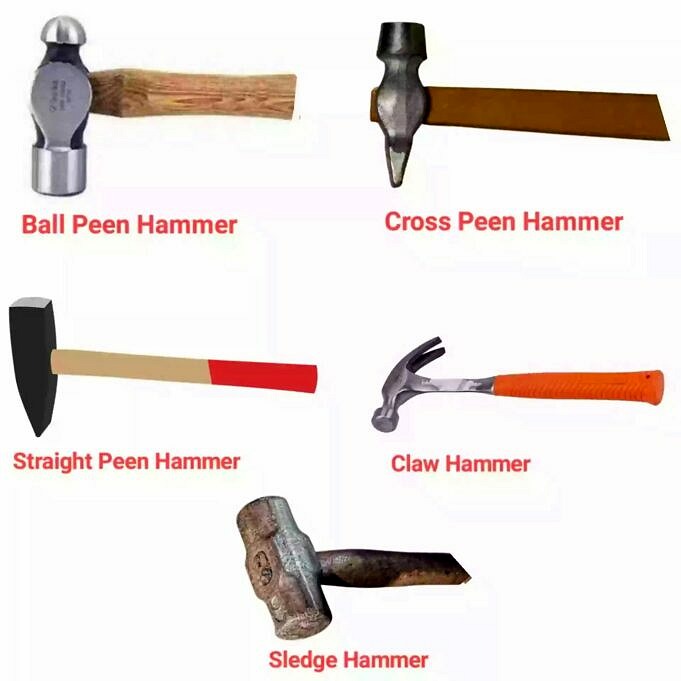Although the hammer is the oldest tool in the world, its role has expanded to include more than just simple construction. There are many types and sizes of hammers available, each with a different weight. Different uses will require different styles. A DIYer will only need one or two styles.
A hammer’s main parts can be broken down into the head, handle, and back. The head is the part that you use to whack things, but it also includes the portion that fits over the handle. This serves as the fulcrum for a claw hammer and helps with nail pulling. The handle can be held for more precision and swing. The back may also include a claw or hook.
This list will give you a better idea of how to use hammers. Continue reading to learn The Different Types of Hammers and their Uses.
Claw Hammer
Source
The most widely used hammer is the claw hammer. You’ve likely used it if you have ever done any kind of handyman work. These hammers are usually made with a wooden, glass fiber, or steel handle. You can have it with or without a rubber grip. However, for greater control and comfort, we recommend that you get a rubber grip. These hammers have a claw with a curving design and a V-shape, which is ideal for cutting nails from timber.
For:
- Prying
- Woodworking
- Finalization
Ball Peen Hammer
Source
The ball peen-hammer is a round design. Its primary functions are to shape metals and rivets. Ball peen hammers are well-suited for professional use. The best thing about this hammer’s design is its versatility. It can be used in many different applications. The handle is usually made of wood. There are many options for these hammers. This hammer is great for general use by professionals as well as DIYers.
For:
- Rounding edges
- Metalworking
- Inspiring and punchy
Club Hammer
Source
The Club Hammer’s double-faced head gives it enough versatility to do many different jobs. You could use it to drive steel nails and masonry nails. This hammer can be used for light demolition and domestic tasks. This hammer can cause serious damage. This hammer can make debris fly everywhere, so it is important to use the right equipment.
For:
- Demolition
- Driving stakes
- Chiseling
Dead Blow Hammer
Source
Although Adead blowhammers can produce a lot of force it also has a head that is designed to deliver soft blows with minimal recoil. It also means that they don’t rebound after striking. These hammers can have a rubber head, plastic or semi-hollow heads filled with lead shot and sand. Many projects can be done with dead blow hammers. These hammers can be used for everything, from woodworking to automotive applications. They can help in dislocating parts, knocking together wood, and fixing small dents.
For:
- Setting joints
- Automotive
- Dent removal
Framing Hammer
Source
The framing, also known as a rip, hammer looks very similar to a claw. It features a straight claw with a waffled head. Named after its primary function of assembling house frames, the hammer was named after it. The hammer’s waffled head prevents slippage when driving nails. This is a wonderful feature. But, I will also add that the hammer mars any surrounding wood, which is a great feature if you are using it for framing, as it won’t be seen until the house is completed.
For framing, hammers are the best.
- Splitting
- Framing
- Small Demolition
Rubber Mallet
The most popular type of mallet is the rubber mallet. It has a rubber head which allows for soft blows. It is suitable for use in upholstery, sheet metal and woodworking. It can also be used to force plasterboard into position without causing damage.
Rubber mallets are ideal for:
- Fitting wooden parts
- Shaping of metal
- Plasterboard
Sledgehammer
For jobs that require strength and power, the sledgehammer can be used. The handles are long and must be held with both hands. They can weigh anywhere from 3-7kg. You can easily break through concrete, stone, and masonry. It can also be used to drive stakes. It is a very popular tool for demolition. But that’s not the only use of this tool. It can be used for lighter work by simply using the head weight.
The best sledgehammers for:
Tack Hammer
Source
The hammer has two claw-like, long heads. One side usually has a magnet. Tack hammers can be small and lightweight. People use tack hammers to drive small, delicate nails. These hammers are also known as upholstery hammers. They are used to attach fabric to furniture. It has a magnetized side, which allows you to place small nails or tacks.
For:
- Precision and lightweight hammering
- Upholstery
- Setting the right pace
There are Different Types Of Hammers and Their Uses. This will hopefully help you to understand the different types of hammers as well as their uses. Do you remember seeing all these types of hammers before? We would love to have your feedback!



